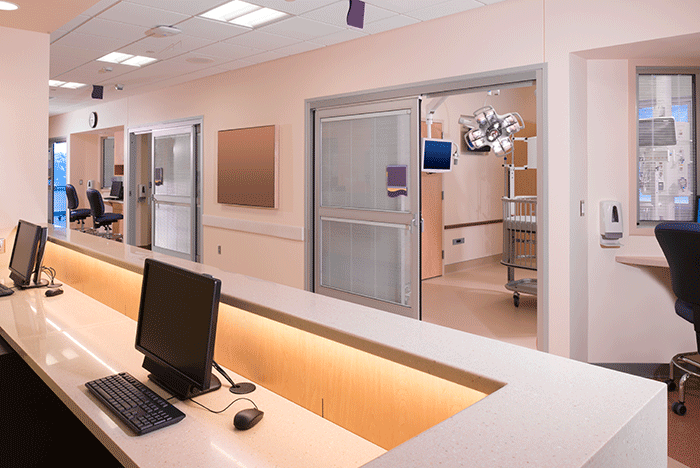The role of visibility in health care facilities

Image by Getty Images
What better time than 2020 to focus on 20/20 vision and visibility in health care? Visibility (among staff and between staff and patients) can affect a variety of important outcomes, including teamwork, communication, efficiency, safety and care quality. Four new publications look at different issues of visibility in a variety of settings.
A study by Xuan and colleagues explores the effect of visibility on a variety of outcomes, including nurse communication, privacy and efficiency in a Chinese hospital. Looking at different types of partitions between the nurse station and the med room, and between the nurse station and the doctor’s office, they found that, while solid walls had a negative impact on staff communication, they did facilitate privacy and the ability to focus.
To strike a balance, the authors suggested a partial glass wall or partial translucent glass in the med room, providing a visual connection while mitigating the chance for interruptions and distractions. They also proposed removing physical barriers (walls) between designated nurse stations and doctor’s offices to support better teamwork.
In another study, Lim and colleagues examined where staff in a primary care clinic like to communicate with one another about patient care and the effect visual exposure to patients had during those clinical conversations. The findings show that staff preferred the privacy afforded by backstage areas with no visual exposure to patients when talking to their peers. The authors discuss the role of visual privacy in backstage areas to prepare for better onstage communication with patients.
While visibility is important in all areas of health care, Gharaveis and colleagues conducted a study focusing on visibility as it relates to teamwork in the emergency department. They confirmed findings from previous research that high visibility can enhance clinical teamwork.
Despite all the communication technologies available, nurses showed a preference for visual connection with colleagues — to ask for help, to read body language and to quickly assess a situation. Interestingly, in large departments with good visibility, as the distance between two locations increased, perceived teamwork quality decreased. Perhaps it’s that visibility matters, but it’s face-to-face visibility that matters more.
All of these studies are interesting, but they may be looking at visibility through a subjective lens, as participants in the studies are offering their individual perceptions. A fourth study by Wingler and colleagues sees things in a different way and provides new insight on virtual reality (VR) as a way to measure visibility objectively. The team found that the data provided by the VR capabilities for motion and eye tracking complemented the more experiential data they also gathered through surveys and interviews, showing alignment between results. Health facilities professionals can find the citations mentioned here, and many others on the topic of visibility, in The Center for Health Design’s Knowledge Repository.
The following citations from The Center for Health Design’s Knowledge Repository of health care design resources were used by the author when writing this column:
- X. Xuan, X. Chen, and Z. Li, “Impacts of Nursing Unit Design on Visibility and Proximity and Its Influences on Communication, Privacy, and Efficiency,” HERD: Health Environments Research & Design Journal, 2019, in press.
- L. Lim et al., “Backstage Staff Communication: The Effects of Different Levels of Visual Exposure to Patients,” HERD: Health Environments Research & Design Journal, 2019, in press.
- A. Gharaveis et al., “The Influence of Visibility on Staff Face-to-Face Communication and Efficiency in Emergency Departments,” Facilities 37, no. 5/6 (2019): 352–63.
- D. Wingler et al., “Using Virtual Reality to Compare Design Alternatives Using Subjective and Objective Evaluation Methods,” HERD: Health Environments Research & Design Journal, 2019, in press.
Melissa Piatkowski, Research Associate, The Center for Health Design




